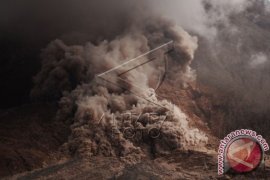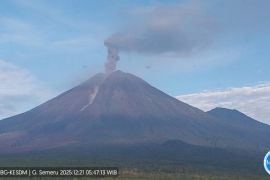The thick gray ash column leaned towards the east and southeast directions, the Mount Sinabung Observation Post of the Center for Volcanology and Geological Hazard Mitigation (PVMBG) stated in a press release on Monday.
Last Saturday, the volcano had erupted for the first time during the COVID-19 pandemic, producing an ash column that reached nearly two thousand meters high above the volcano’s peak, or some 4,460 meters above sea level.
Currently, the alert status of Mount Sinabung is at Level III. Local residents and visitors are also prohibited from venturing within a three-kilometer (km) radial radius of the summit of Mount Sinabung and a sectoral radius of 5 km for the south-east sectors, and 4 km for the east-north sectors. In the event of an ash rain, the people are advised to wear masks while venturing outdoors to lower the health impact of the volcanic ash.
Local people living near riverbanks, whose upstream are in the vicinity of Mount Sinabung, are urged to remain vigilant to the dangers of lava floods.
After remaining inactive for four centuries, Mount Sinabung has sprung back to life since 2010 and erupted sporadically. The natural disaster has led to the displacement of tens of thousands of people.
Mt Sinabung's eruption had claimed two lives in 2010 and 15 lives in 2015. The last known eruption, prior to recent times, occurred in the year 1600.
The government relocated the displaced people to new permanent settlement areas away from the volcano. Related news: 1,500 face masks distributed following Mt Sinabung's eruption
Related news: Volcanic ash from Mt Sinabung affects four sub-districts
EDITED BY INE
Translator: Nur A Sitorus, Fardah
Editor: Suharto
Copyright © ANTARA 2020












